Schoolyards that Both Students and Communities Enjoy
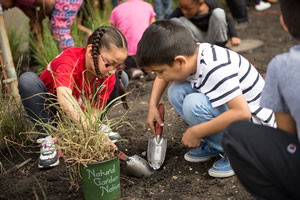
PHOTO COURTESY OF SPACE TO GROW
In 2012, leaders of openlands, which was founded
in 1963 as a program of the Welfare Council of Metropolitan Chicago
and is one of the oldest metropolitan conservation organizations
in the nation, and Chicago-based Healthy Schools Campaign
(HSC), a nonprofit organization dedicated to ensuring that all
students have access to healthy school environments where they can
learn and thrive, met to explore how they could work together to
benefit Chicago Public Schools’ (CPS) crumbling schoolyards.
Both organizations were already working with CPS in different capacities.
Openlands had a program installing school gardens (58 were
complete) to provide access to nature for their respective communities,
teachers and students. Healthy Schools was helping administrators create nutrition standards, advocating for reinstating recess and
assisting the district in revamping its physical education program.
It was through its work with the district that Healthy Schools leaders
discovered that many CPS schoolyards were in disrepair and unable to
support all the positive changes the district was making.
The leaders did indeed come up with a plan, which they named
Space to Grow. In addition to Openlands and HSC, the program
was developed by the region’s two public water utilities, Metropolitan
Water Reclamation District of Greater Chicago (MWRD) and
Chicago Department of Water Management (CDWM), and CPS.
School Planning & Management recently spoke with Kristin Lo
Verde, Openlands’ education manager, about Space to Grow. Here’s
what the program is accomplishing in the fourth largest school
district in the nation, educating nearly 400,000 students in 652
schools, of which 480 are elementary.
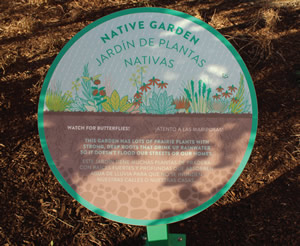
PHOTO COURTESY OF SPACE TO GROW
SPM: How did the Space to Grow program get started?
Lo Verde: Noting that the schoolyards were deteriorating and that
not all of them had playgrounds, we wondered what could we do
with these outdoor spaces to support the district. We knew that
MWRD and CDWM had dollars available to install green infrastructure
components, so we brought them into the conversation.
These organizations had not previously worked together as a
group, and each had different goals for the program. As you can imagine, a lot of time and discussion went
into determining how the goals fit together
and creating a joint vision to move the program
forward. The resulting program goals
are promoting health and wellness, outdoor
learning and stormwater management.
The water utilities provide capital funding,
help identify schools in neighborhoods
with flooding problems and contribute
expertise to the design and construction of
green infrastructure elements. CPS provides
capital funding and expertise, hires the
design teams and manages the construction.
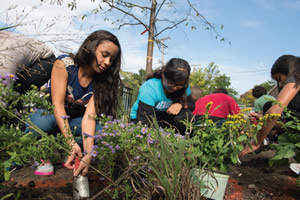
PHOTO COURTESY OF SPACE TO GROW
Spaces to Grow. In 2012, leaders of Openlands, a program of the Welfare
Council of Metropolitan Chicago, and Chicago-based Healthy Schools
Campaign (HSC), met to explore how they could work together to benefit
Chicago Public Schools’ (CPS) crumbling schoolyards. Both organizations
were already working with CPS in different capacities. Openlands had a
program installing school gardens (58 were complete). Healthy Schools was
helping administrators create nutrition standards, advocating for reinstating
recess and assisting the district in revamping its physical education program.
The leaders came up with a plan, which they named Space to Grow.
SPM: What is the cost of each schoolyard?
Lo Verde: Capital funding for each project
is $1.5 million dollars. That includes design,
construction, all above-ground elements
and green infrastructure components.
The schoolyards include play equipment,
outdoor classrooms, sports fields, basketball
courts and even edible gardens to promote
and encourage outdoor learning, nutrition
education, access to healthy foods and
physical activity.
SPM: Describe some of the schoolyards
that are completed.
Lo Verde: Nine schoolyards are complete;
each schoolyard represents the needs of
each school community. One of the first
schoolyards was an acre of crumbling
asphalt. When it would rain, the water
would sit on the schoolyard, so the students
couldn’t use the space at all. Half of the
schoolyard was designed to include basketball
hoops, a volleyball court, an outdoor
classroom, two playgrounds, native gardens
and raised beds for vegetable gardens.
This half of the schoolyard captures all
stormwater that falls on the site. Now, after
it rains, students can use the space right
away. The other half was resurfaced and
includes a running track.
Another schoolyard features a runnel —
a blend of “river” and “tunnel” — where water
comes off the roof and goes through the
runnel into a native garden. The process can
be seen, which highlights Space to Grow’s
stormwater element. In fact, all of the schoolyards
include this green infrastructure and,
at some of them, it is daylighted.
Commissioner Kari Steele reports that,
combined, the completed projects retain
more than 1.6 million gallons of stormwater
on site, which keeps runoff out of the
sewer system during the heaviest of storms.
She also notes that the stormwater management
and development of urban green
spaces contributes to cleaner water, less
flooding, fewer combined sewer overflows,
reduced heat island effect, and enhanced
and increased regional biodiversity.
SPM: How is the decision made as to which
schoolyards get transformed?
Lo Verde: Every schoolyard is unique, as
is every community. The ones we’ve completed
so far are ones that were in desperate
need of improvement. The ones we choose
are based on a list of criteria. For example,
there is a percentage of flooding that
occurs, whether they have a playground,
the schoolyard size (needs to be greater
than 30,000 square feet), the amount of impermeable
surfaces on the schoolyard, the
amount of open space deficit, income level
and obesity rates in the community.
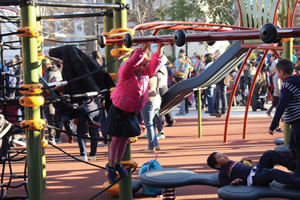
PHOTO COURTESY OF SPACE TO GROW
SPM: What changes/improvements are
being made to the program as each schoolyard
is completed?
Lo Verde: Community engagement is a key
program component. We use an inclusive planning process to engage all users of the schoolyard (students, teachers,
parents, community members). Since the pilot year, our community
engagement process has been strengthened so that each schoolyard
is designed and built per each community’s needs and vision.
We’ve also created a design manual to assist the designers and
share lessons learned. For instance, when trees are incorporated
into the design, we ask the designers to see if a shade tree would be
beneficial in that area to increase shade. Also, we need to be careful
with having gardens near very active spaces like turf fields.
And we’re still working on looking at the overall maintenance
plan of each schoolyard once construction is complete. Each
schoolyard is a different based on the elements, green infrastructure
and landscaping. A process to streamline the operations and
maintenance is in the works.
SPM: What happens after each schoolyard is open?
Lo Verde: We continue to support each schoolyard after it is installed.
Specifically, Openlands and HSC commit to three years of
support. We have designed a comprehensive approach that ensures
the schoolyard is integrated into school life regardless of changes
in leadership or staffing.
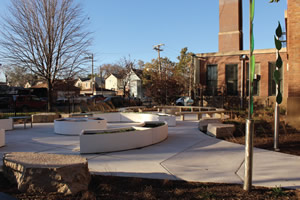
PHOTO COURTESY OF SPACE TO GROW
Multipurpose Schoolyard. Nine Chicago Public Schoolyards have been
redesigned and transformed since the program began. Each is designed
according to the needs of the school and community. One common factor
is the green infrastructure element that involves the capture of stormwater.
The completed projects retain more than 1.6 million gallons of stormwater,
which keeps runoff out of the sewer system.
One way we offer support is through a number of teacher
workshops. One is a stormwater workshop where we discuss what
is happening on the schoolyard in relation to capturing stormwater.
There is a lot happening underground. Another workshop discusses
the benefits of teaching outdoors and offering best practices on how
to do it. HSC facilitates a workshop focusing on health and wellness.
The teacher workshops support the program’s three goals.
A community stormwater workshop is also held for parents
and community members. It’s similar to the teacher workshop
with a focus on what the community members can do at home to
help with stormwater management. Participants receive a free rain
barrel or free flat of native plants, depending on what they want. A
garden workshop is also offered to the teachers, parents and community
members on how to use and maintain the gardens. We do
this workshop within the first year of each schoolyard’s opening.
We also support the development of a wellness team to ensure
each schoolyard is incorporated into physical education and recess
plans, a garden team to take ownership of the garden or gardens,
and parent leadership.
Our support plan for each school is tailored to the schoolyard’s
and community’s needs. For example, one school recently had some
staff turnover, so we repeated our workshops for the benefit of the
new staff. We have to be, and are, flexible in the support we provide.
SPM: What benefits have the schoolyards wrought?
Lo Verde: We have completed a couple of program evaluations
via focus groups with parents and the community. One immediate
benefit they note is a reduction in behaviorial and discipline
issues. Students are eager to go outside, even in inclement weather.
Another is that the schoolyards are being used by community
members; they’re getting outside — using the track, sitting in the
garden spaces and having coffee, and bringing their children to the
playgrounds.
School leaders indicate that the schoolyards that are activated
by community members realize a decrease in crime and graffiti.
In the design process of one schoolyard specifically, community
members desired a tall fence around it to prevent people from
using it inappropriately. We told them that the schoolyards can’t
be locked at night; they’re open to the community after school and
on the weekends. Then we asked what else we could do to make it a
positive place that people desire to use and use appropriately. As a
result, they took ownership of the space.
We’re seeing that sense of ownership in all the schoolyards. We
sponsor stewardship days where we ask the community to join us
for weeding, mulching and clean up. Even outside those days, we
see people picking up garbage and maintaining the spaces.
SPM: Which is more important, creating vibrant outdoor spaces or
addressing environmental concerns?
Lo Verde: Well, that depends on which partner you’re asking.
We’re fortunate to have a program that’s able to address both
concerns.
SPM: What is the future of the Space to Grow program?
Lo Verde: We have a goal to have 34 schoolyards designed, constructed
and activated by 2019. After 2019, our plan is to continue with
the program and, while we’re not sure in what capacity that will be, we
would love to see a Space to Grow schoolyard at every CPS school.
For more information about Space to Grow, visit www.spacetogrowchicago.org or www.mwrd.org.
SPACE TO GROW IS AN AWARD-WINNING PROGRAM
According to Water Online (www.wateronline.com), the leading source of technical information
and thought leadership for the drinking water and wastewater treatment community,
Space to Grow has won a number of awards. Check it out:
- 2016 Best of Green School Award for Collaboration by the Center for Green Schools at the U.S.
Green Building Council in collaboration with the Green Schools National Network;
- Sustainability award from the Illinois Association for Floodplain and Stormwater Management;
- New Champions” award from the National Physical Activity Plan Alliance; and
- 2016 National Association of Flood and Stormwater Management Agencies’ (NAFSMA) first place
Green Infrastructure award.
This article originally appeared in the issue of .